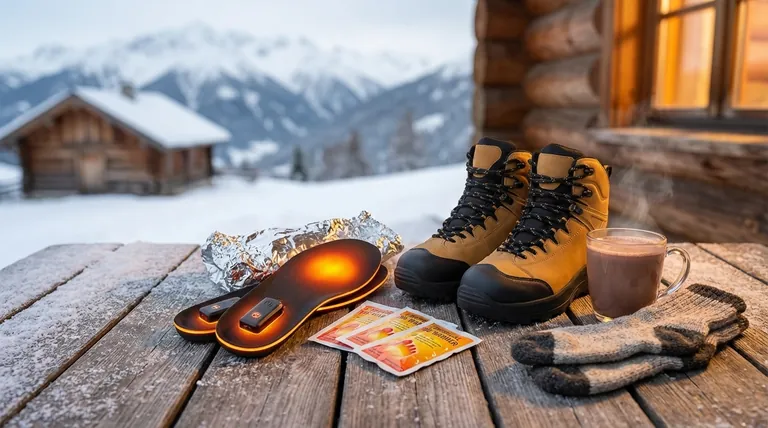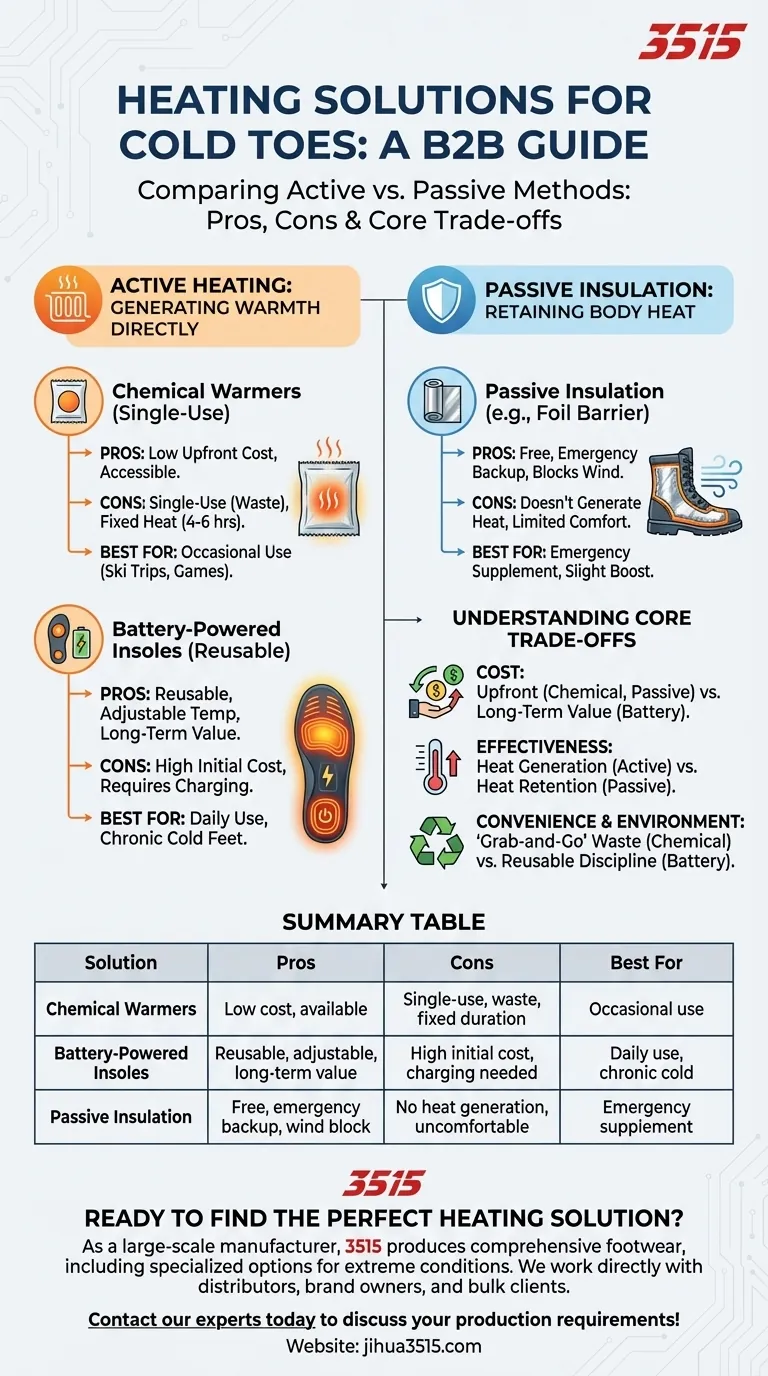To effectively combat cold toes, you must choose between active heating solutions like disposable chemical warmers and reusable battery-powered insoles, or passive insulation methods like foil wraps. Chemical warmers are cheap but create waste, battery-powered options are a reusable but expensive investment, and passive methods are free but primarily block wind rather than generating heat.
The core decision is not simply about warmth, but about balancing your specific needs against three key factors: the upfront cost versus long-term expense, the convenience of disposability versus the sustainability of reusable technology, and the intensity of active heat generation versus the subtlety of passive heat retention.

Active Heating: Generating Warmth Directly
Active solutions introduce an external heat source to your footwear. They are the most effective option for maintaining circulation and comfort in truly cold conditions.
Chemical Warmers (The Single-Use Solution)
These small packets contain a mixture of iron powder, salt, and other ingredients that create an exothermic reaction when exposed to air.
Their primary advantage is low upfront cost and accessibility. You can buy them almost anywhere for just a few dollars.
However, their disposable nature is a significant drawback. They are a single-use product, contributing to landfill waste, and their heat output is fixed for a duration of roughly 4-6 hours.
Battery-Powered Insoles (The Reusable Investment)
These are insoles with integrated heating elements and a rechargeable battery. They represent a modern, high-tech approach to foot comfort.
The key benefit is reusability and control. Though the initial cost is high, you can use them for years, and most models offer adjustable temperature settings.
The main disadvantage is the high initial price and the need to remember to charge them. If the battery dies, they provide no more warmth than a standard insole.
Passive Insulation: Retaining Your Body's Heat
Passive methods do not generate their own heat. Instead, they work by creating an additional barrier to prevent your body's natural warmth from escaping and to block external cold, particularly wind.
The Principle of a Barrier
Using materials like newspaper or aluminum foil inside your boots creates a non-breathable layer.
This layer acts as a vapor barrier to keep socks dry from external moisture and as a windproof shield, which is a major factor in heat loss.
Pros and Cons of Passive Methods
The most obvious advantage is that these materials are essentially free and readily available in an emergency.
The downside is their limited effectiveness. They can't warm up already cold feet and can feel crinkly or uncomfortable. They are best seen as a supplement or an emergency measure, not a primary solution.
Understanding the Core Trade-offs
Choosing the right solution requires a clear understanding of what you are giving up for what you gain.
Cost: Upfront vs. Long-Term
Battery-powered insoles have a high initial purchase price but can be cheaper over several years of frequent use. Chemical warmers are cheap per use but the cost adds up over time.
Effectiveness: Heat Generation vs. Heat Retention
Active heaters provide consistent, reliable warmth and are far superior for preventing cold from setting in. Passive methods only slow down heat loss and are ineffective once your feet are already cold.
Convenience & Environmental Impact
Chemical warmers are a simple "grab-and-go" option but generate continuous waste. Battery insoles are environmentally friendlier in the long run but require the discipline of regular recharging.
Making the Right Choice for Your Needs
Your specific goal will determine the ideal solution.
- If your primary focus is an affordable, occasional fix for a ski trip or football game: Chemical warmers offer the best combination of low cost and effective heat for infrequent use.
- If your primary focus is consistent, long-term relief for daily commutes or chronic cold feet: Battery-powered insoles are a worthwhile investment for their reusability and adjustable warmth.
- If your primary focus is a no-cost emergency backup or a slight boost to your current setup: Passive insulation like a foil wrap can provide an extra layer of protection when you're in a pinch.
Ultimately, the best way to keep your toes warm is to choose the tool that directly matches your activity, budget, and how frequently you face the cold.
Summary Table:
| Solution | Pros | Cons | Best For |
|---|---|---|---|
| Chemical Warmers | Low upfront cost, widely available | Single-use, creates waste, fixed heat duration | Occasional use (e.g., ski trips, games) |
| Battery-Powered Insoles | Reusable, adjustable temperature, long-term value | High initial cost, requires charging | Daily use, chronic cold feet |
| Passive Insulation (e.g., foil) | Free, emergency backup, blocks wind | Doesn't generate heat, can be uncomfortable | Emergency supplement, slight boost |
Ready to find the perfect heating solution for your footwear needs?
As a large-scale manufacturer, 3515 produces a comprehensive range of footwear, including specialized options for extreme conditions. We work directly with distributors, brand owners, and bulk clients to deliver high-quality, reliable products. Let us help you develop or source the ideal footwear solution to keep your customers warm.
Contact our experts today to discuss your production requirements!
Visual Guide

Related Products
- Premium Insulated Safety Boots and Shoes for Wholesale & Bulk Orders
- Safety Footwear Wholesale Manufacturer for Custom OEM/ODM Production
- Wholesale Safety Footwear Manufacturer for Bulk & Custom OEM Orders
- Heavy-Duty Waterproof Nubuck Safety Boots Safety Shoes for Bulk Supply
- Premium Wholesale Tactical Style Safety Shoes Boots with Quick Lacing
People Also Ask
- Why is it important to keep feet warm in winter? Protect Your Health & Circulation
- Can insulated work boots be worn in warmer weather? Avoid Discomfort and Foot Health Risks
- Why is it important to keep feet dry during winter? Prevent Frostbite & Infections
- What is the best way to protect feet from frostbite in winter? A Complete System for Dry, Warm Feet
- What features should one look for when selecting supportive winter footwear? Secure Your Stride with the Right Support



















